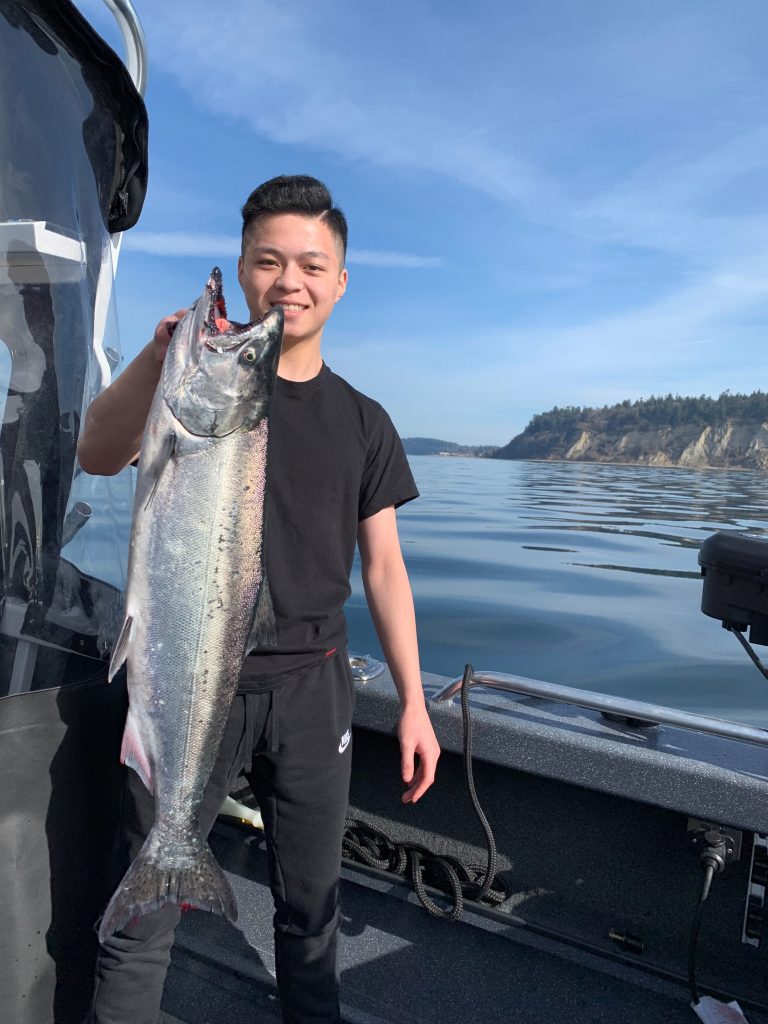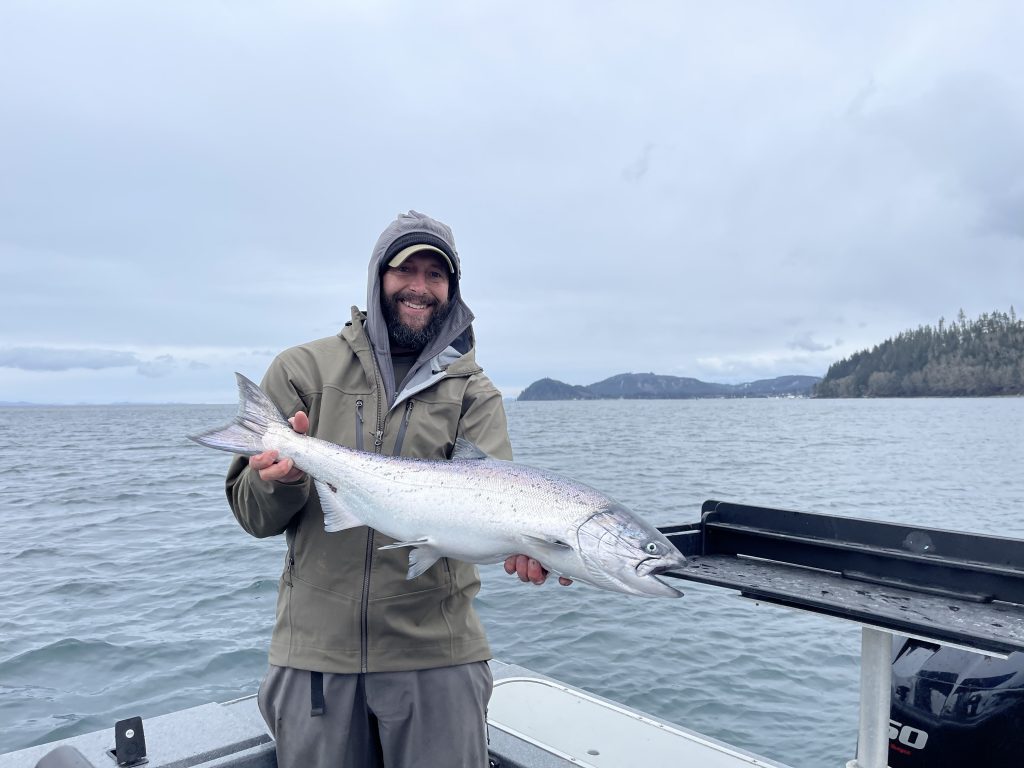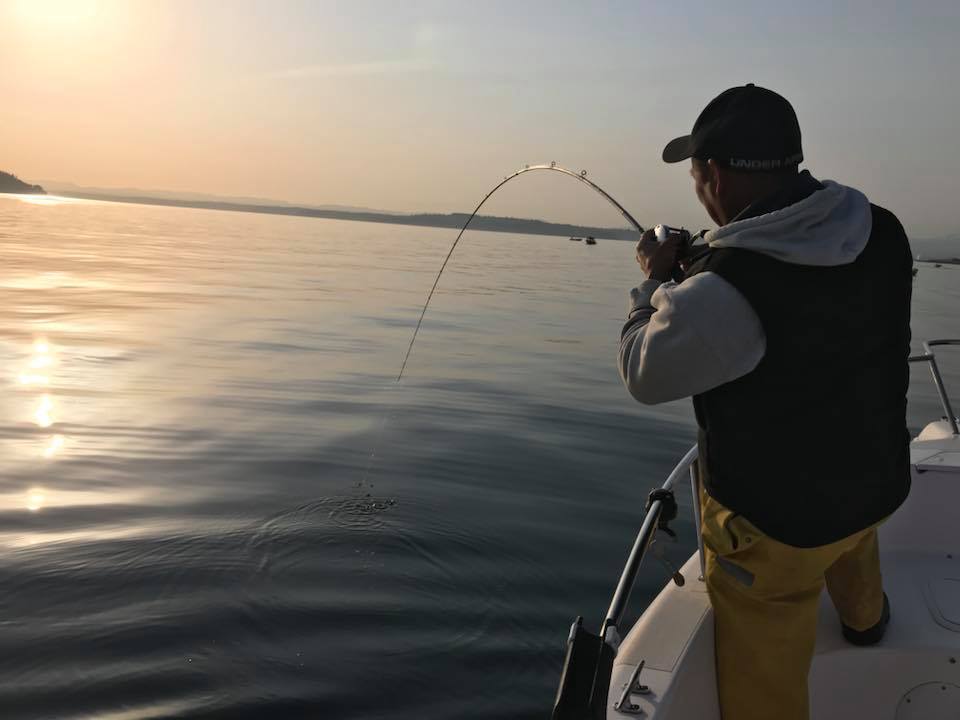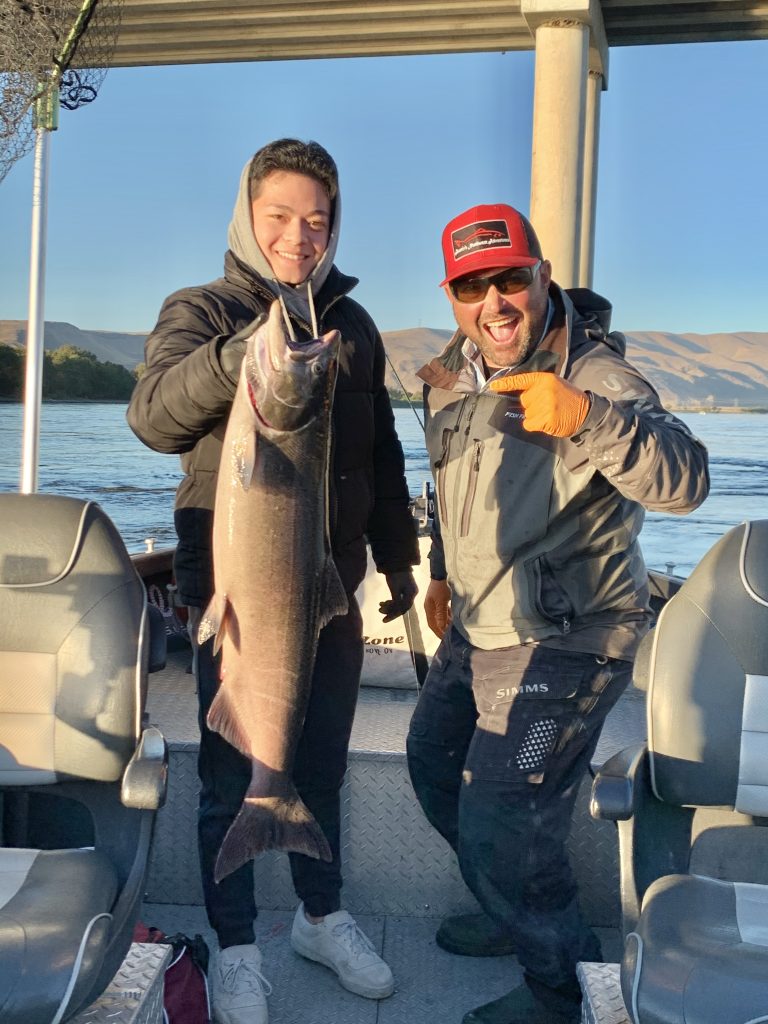Washington salmon seasons set will be fairly like 2022, and nearly 4.0-million pink salmon will provide an added salmon species to catch this summer Leave a reply

Contributed by Mark Yuasa, WDFW
Anglers will be able to look forward to fishing opportunities that’ll likely mirror last season, plus a forecasted robust return of nearly 4.0 million pink salmon heading to Puget Sound, and a stable Chinook and coho forecasts will boost ocean fisheries too.
The process in developing Puget Sound salmon seasons – jointly developed by the Washington Department of Fish and Wildlife (WDFW) and treaty tribal co-managers – were tentatively set Thursday at a week-long Pacific Fishery Management Council (PFMC) meeting held in Foster City, Calif.

A rather robust pink forecast of 3,950,917 – compared to 2,925,681 in 2021 and 608,388 in 2019 – is predicted this summer for Puget Sound, Hood Canal, and Strait of Juan de Fuca. The 2023 pink forecast is very close to the 10-year average of 4-million pinks. While relatively small (3 to 5 pounds), pinks are the fastest growing Pacific salmon species and return in bulk during odd-numbered years after spending two years in the ocean before migrating to natal rivers.
Fishing for pinks in Puget Sound was very good at times in 2021 and 2019 during August and September. Pinks will remain part of daily catch limits in marine fisheries and limits in freshwater areas will be watershed specific.
The combined Puget Sound hatchery and the wild coho forecast is 800,560 compared to 636,952 in 2022; 614,948 in 2021; 504,604 in 2020; 708,521 in 2019; and 557,149 in 2018.
The coast-wide hatchery coho forecast shows an 20% improvement and wild coho are down 4% compared to 2022 forecast. The recent 10-year average for hatchery coho is up 96% and the wild coho is up 43%.
The 2023 Puget Sound hatchery Chinook forecast is up 34% but the wild forecast is down 29% from the recent 10-year average. The hatchery forecast is up 5% but the wild forecast is down 2% compared to the 2022 forecast. The total hatchery/wild numbers are up 22% from the 10-year average and up 4% from the 2022 forecast.
The 2023 Puget Sound-wide wild Chinook forecast is 29,780 (28,992 in 2022 and 26,918 in 2021) and the hatchery forecast is 228,980 (201,059 in 2022 and 202,185 in 2021).

Salmon fishing opportunities in 2023-2024
A summer hatchery-marked Chinook fishery in the San Juan Islands (Marine Area 7) is planned to open July 13-15. Fishing will be open Thursdays to Saturdays. This allows WDFW to assess the fisheries on a weekly basis to see if additional days can be added on after the initial opener. In Marine Area 7, once the 2,181 Chinook quota is achieved (1,800 in 2022, 1,382 in 2021 and 1,562 in 2020) it will close and then reopen on Aug. 1-31 for hatchery coho only and then Sept. 1-30 for all coho.
A summer hatchery-marked Chinook and coho fishery in northern Puget Sound (Marine Area 9) is planned to open July 13-15 with a chance to reopen July 20-22 and July 27-29 (WDFW will assess after each three-day fishery to see if additional time can be added). Fishing will be open Thursdays to Saturdays with a 4,300 Chinook quota (4,700 in 2022 and 2021 and 5,600 in 2020). The Marine Area 9 planned opener for hatchery coho is July 30-Sept. 17 and open for non-select coho from Sept. 18-31.
In central Puget Sound (Marine Area 10) the fishery targeting coho only is planned to open June 1 through July 12, and then the hatchery-marked Chinook fishery open daily from July 13 through Aug. 31 although retaining hatchery Chinook could close sooner if the 3,566 quota is achieved (3,966 in 2022, 3,718 in 2021 and 4,100 in 2020). Fishing then remains open for all coho from Sept. 9 through Oct. 31. The 2024 hatchery winter Chinook fishery in Marine Area 10 is open during March 1-April 15.
There will also be a small window of opportunity in inner-Elliott Bay from Aug. 4-7 and additional openings may occur.
One of the highlights will be south central Puget Sound (Marine Area 11) where hatchery-marked Chinook is tentatively set to open June 1 through Sept. 30 and closes once the Chinook quota is achieved (recall the June season is managed with a separate quota was very brief in 2022). The June Chinook catch quota is 1,423 (580 in 2022 and 431 in 2021) and remaining summer quota is 3,379 (2,816 in 2022 and 2,656 in 2021). Marine Area 11 is open for coho only from Oct. 1-31. The 2024 hatchery winter Chinook fishery in Marine Area 11 is open during March 1-April 15.

In the Strait of Juan de Fuca, Sekiu (Marine Area 5) is planned to open from July 1 through Aug. 15 for hatchery-marked Chinook and coho, and the Chinook fishery could close sooner if the 3,906 quota is achieved (3,890 in 2022 and 4,077 in 2021). Marine Area 5 is open Aug. 16 through Sept. 30 for a hatchery-marked coho fishery, and Oct. 1-15 for all coho. The 2024 winter hatchery Chinook season will be open April 1-30 (one month less than 2023) with a Chinook quota of 1,400 (1,726 in 2022).
The eastern Strait of Juan de Fuca, Port Angeles (Marine Area 6) – west of a true north/south line through the #2 Buoy immediately east of Ediz Hook – is planned to open July 1 through Aug. 15 for hatchery-marked Chinook and coho, and the Chinook fishery could close sooner if the 7,258 quota is achieved (6,050 in 2022 and 4,769 in 2021). The area east of the of the boundary is open July 1 through Aug. 15 for hatchery-marked coho only. All Marine Area 6 is open Aug. 16 through Sept. 30 for a hatchery-marked coho fishery, and Oct. 1-15 for all coho. The Dungeness Bay coho fishery is open Oct. 16 through Nov. 30.
In other positive news, Marine Area 8-2 is planned to open Aug. 1 through Sept. 24 for all coho (recall in 2022, only the southern half of Area 8-2 was open for hatchery coho only). The east side of Whidbey Island (Marine Area 8-1) will open Aug. 1 through Sept. 30 for all coho only.
The Tulalip Bay Terminal Chinook Fishery is planned to open May 26 through Sept. 5 (Fridays through noon Mondays only of each week) and open Sept. 9-24 (weekends only).
In southern Puget Sound (Marine Area 13) fishing is open year-round for salmon. From July 1 to Sept. 30 the hatchery chinook minimum size limit is 20 inches; release wild coho and chinook and all chum. From May 15 to June 30 and Oct. 1 to May 14 of 2024 the hatchery chinook minimum size limit is 22 inches; release wild coho and chinook and all chum.
Hood Canal south of Ayock Point (Marine Area 12) tentative opener is July 10 to Sept. 30 for coho and hatchery Chinook and open from Oct. 1-31 for coho only and release chum Oct. 1-15. Hood Canal north of Ayock Point is open July 10 to Oct. 31 for a fishery directed at coho only.

Look for decent coastal salmon fisheries
Washington’s ocean salmon fisheries off Neah Bay, La Push, Westport and Ilwaco (Marine Areas 4, 3, 2, and 1) will likely see good fishing this summer due to improved forecast for some Chinook stocks and a second consecutive year of large forecasts for hatchery coho. Fishery managers agreed during this week’s PFMC meeting to recreational ocean quotas of 39,000 Chinook and 159,600 marked coho.
Neah Bay (Marine Area 4) and La Push (Marine Area 3) will open for salmon retention beginning June 17, followed by Ilwaco (Marine Area 1) and Westport-Ocean Shores (Marine Area 2) on June 24. All areas are scheduled to remain open until Sept. 30 or until quotas are met, with species and size restrictions dependent on the area.
In Grays Harbor (Marine Area 2-2) the Humptulips North Bay salmon season opens Aug. 1 for retention of hatchery Chinook and coho, and the East Grays Harbor opens Sept. 16 for coho retention only. In Willapa Bay (Marine Area 2-1) the coho and hatchery Chinook season opens Aug. 1. The Willapa Bay Control Zone will be open for salmon in 2023, which was closed in 2022.

Columbia River should be a bright spot
Summer salmon fisheries on the Columbia River are expected to be improved compared to last year, according to WDFW fishery managers, with fishing from the Astoria-Megler bridge to Highway 395 bridge in Pasco and below Bonneville Dam scheduled to open June 16 through July 31. Sockeye retention is expected to be allowed in the daily salmonid bag limit beginning June 16.
Fall fisheries from Buoy 10 to the Highway 395 bridge in Pasco is planned for an Aug. 1 opener, with different dates by area for Chinook and coho, and includes steelhead restrictions throughout the river. Another strong coho run is expected and the Chinook run size is better than the 2022 forecast but below the actual return and should provide for some good fishing opportunities.
The Columbia River fall Chinook forecasts appear better, and the forecast is 545,300 compared to forecast of 484,900 and an actual return of 674,786 in 2022. The 2023 forecast is like the recent three-year average return of about 577,000.
In February, the Oregon Production Index – which provides ocean coho abundance forecasts – was released and revealed an estimated 1,135,700 coho to arrive off the Washington coast. That is down a bit from a forecast of 1,225,900 and an actual return of 887,500 in 2022. The Columbia River subtotal forecast is 886,100 coho compared to 997,200 in 2022 and an actual return of 685,200.
The Upper Columbia summer Chinook forecast of 84,800 in 2023 is up from a 2022 forecast of 56,300 and an actual return of 78,444. This run is the main driver for recreational fisheries from the Rocky Reach Dam to Chelan Falls as well as many other open areas further upstream at Brewster and downstream near Wenatchee and Entiat.
The 2022 upper Columbia summer Chinook return was the seventh largest since 1980, totaling 78,494 adults, compared to the preseason forecast of 56,300 adults.

The Columbia sockeye forecast is a modest 234,500 in 2023. In 2022, the forecast was 198,700 and the actual return hit a robust 664,935, which was the largest since Bonneville Dam was erected in 1938.
The huge 2022 return of sockeye to the Columbia River was two times the recent 10-year average return and was the largest return since at least 1938 when Bonneville Dam was first erected. The 2022 return included at least 147,473 Wenatchee; 513,317 Okanogan; and 2,329 Snake River stock sockeye returning to the Columbia River.
The breakdown for 2023 Columbia River sockeye run includes 44,300 Wenatchee stock, 187,400 Okanogan stock, and 2,600 Snake River stock. The forecast is 73% of the 2013–2022 average total return of 323,107 fish.
A Lake Wenatchee sockeye fishery could occur sometime in August but will be based on in-season monitoring of fish returning to Tumwater Dam.
(Mark Yuasa is a Washington Department of Fish and Wildlife Communications Manager. He also has contributed numerous blogs to the KIRO/ESPN The Outdoor Line and was the outdoor reporter at The Seattle Times for 28 years.)

